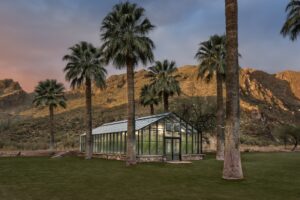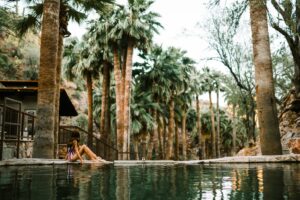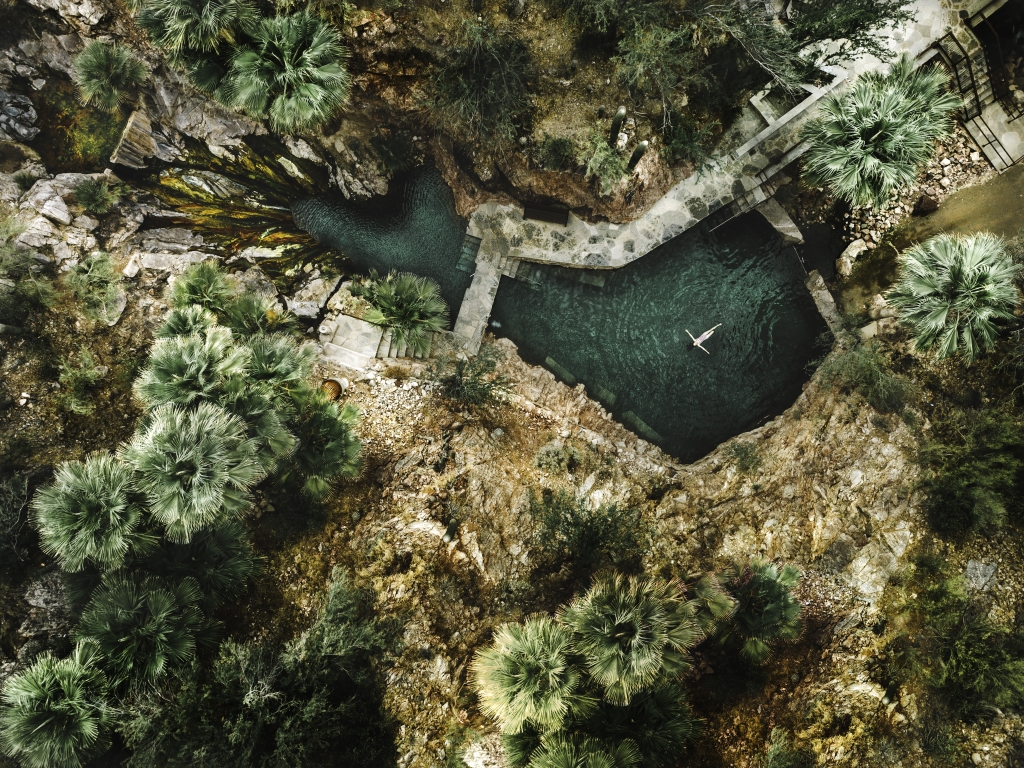Writer Rebecca L. Rhoades // Photography Courtesy of Castle Hot Springs



Following agronomist Ian Beger around the expansive gardens at Castle Hot Springs is like spending time with Mother Nature’s version of Willy Wonka.
Knowledgeable and passionate to a fault about the fruits and vegetables grown at the luxury desert resort, he eagerly shares random tidbits about each plant as well as gardening advice.
As he strides through the rows of verdant and flowering greenery, he’s constantly fussing — plucking, picking and trimming with an acute awareness of every leaf, stalk and petal. He reaches down and removes a fleshy, ruffled leaf studded with shimmering crystals that look like hoarfrost. Known as glacier lettuce, the edible succulent is crisp and mellow with a slight seawater bite.
“This plant really does a good job of expressing what the spring water does to the produce,” Beger explains. “What you’re tasting is almost like mineral water concentrates. It’s almost like tasting the ocean.”
Glacier lettuce is just one of the more than 150 varieties of produce that are grown each year as part of Castle Hot Springs’ agriculture program. As farm manager, Beger is responsible for the development and growth of the program, which now garners as much praise as the property’s natural pools of therapeutic, mineral-rich thermal water.



Dining in the Desert
Castle Hot Springs is a historic resort tucked away in the Bradshaw Mountains, about 50 miles north of downtown Phoenix. Named for the hot mineral springs that flow from an underground cistern into a series of rejuvenating pools, the landmark lodging dates back to the late 1800s and was once the winter playground of some of America’s wealthiest and most well-known families, including the Rockefellers, Roosevelts, Wrigleys, Vanderbilts, Cabots and Carnegies.
In the mid-1970s, a fire destroyed much of the property, and the resort remained abandoned for more than 40 years. In 2014, a local businessman and his wife purchased it with plans to return it to its previous glory. Five years later, Castle Hot Springs re-opened to worldwide praise. It is now considered the nation’s most luxurious hot springs resort.
Castle Hot Springs is also one of many wellness resorts that use fresh organic ingredients grown mere steps away from guest accommodations. In fact, it is frequently mentioned in the same breath as Tennessee’s legendary Blackberry Farm, which is on every gourmand’s bucket list.
Here in the desert, bartenders use fresh-pressed sugarcane juice, grown on-site, to sweeten house-made lemonade. The hibiscus tea, a refreshingly cool fuschia-hued sip that’s handed out to guests upon arrival, is made with hibiscus flowers and blue spice basil grown on the farm. Fresh-picked tomatoes, celery, onions, garlic and herbs serve as the base for the resort’s bloody mary mix. In the restaurant, menus are based on the day’s harvest.
When the resort first opened, chef Christopher Brugman was recruited from Mountain Shadows to launch Harvest, the property’s on-site restaurant. Brugman left in late 2020, and sous chef John Amann took over as executive chef.
“Our concept has changed a lot since our first season,” Amann says. “We had this farm in our backyard, and it wasn’t as much of a highlight as it is now. And that was something I was always passionate about. When Christopher left, it opened up a great opportunity. Our restaurant is called Harvest; I wanted to actually do something about that. There was a natural evolution of utilizing the produce we grow and minimizing waste, which is something we really focus on here.”
Initially, the resort had a single garden — a fan-shaped planting area that stretched out from the southwest corner of the main lodge, a canary-yellow structure that houses the resort’s restaurant and lounge, Bar 1896. Known as the culinary garden, it provided kitchen staff with instant access to ingredients such as herbs, microgreens and edible flowers.
“When I first came out here, this was all we really had, along with the citrus trees and greenhouse,” Beger recalls. “We realized after the first year that we wanted to provide more of the substance of the food — the carrots, the cauliflower, broccoli — but we really couldn’t provide most of that from this space.”
Amann concurs.
“We learned really quick that we needed more farm space,” he says.
The addition of a 1-acre garden, complete with farm offices and high tunnel greenhouses, allowed the farm and culinary teams to expand the amount of produce that’s grown on-site — supplying upward of 80% of the restaurant’s vegetables. That’s a lot of produce, considering that the restaurant caters to 60 guests each day for breakfast, lunch and dinner.



A Locavore’s Dream
The new farm, combined with the original culinary garden, tomato greenhouse, a 3-acre agave farm — which will be used to produce a house-made spirit — a quarter-acre of stone fruit trees and a citrus orchard, increases the amount of cultivatable space at Castle Hot Springs to 5 acres.
“Our main goal is to provide the best quality fruits, vegetables and herbs to the kitchen, bar and, ultimately, the guests,” Beger says. “We’re focused on flavor more than anything.”
More than 150 varieties of produce are grown on-site. Getting the perfect mix of quality, flavor and yield — and even uniqueness for those signature dishes — has been one of Beger’s goals since day one.
“We have very unique growing conditions,” he explains. “We use spring water for everything, and we’re in a valley. It’s unlike anywhere else that I’ve ever grown before. So we want to try out as many varieties as we can. I call it a shotgun approach to agriculture.”
So far, the farm team has trialed more than 1,000 varieties of produce to find out which ones thrive in the hot, arid desert environs. Each year, the team experiments with about 30% new crops. Produce that’s not consumed immediately is pickled, cured or fermented, preserving the flavors for out-of-season use. Herbs and flowers are dried for use in teas and simple syrups.
In addition to the freshest fruits and vegetables, this season, for the first time, the restaurant will be serving farm-fresh eggs thanks to the acquisition of 100 laying hens.
For Amann, this diversification allows for greater creativity in the kitchen by challenging the staff to develop recipes that utilize the ever-changing harvest.
“Ian’s lucky because he has one customer,” Amann says. “I’m buying it all. The challenge for the back of the house is how we are going to use all of the stuff from the farm. It has really helped me find my culinary style.”
One guest-favorite dish is the mokum carrot bisque. Mokum carrots are small in size and sweet in flavor.
“It’s the best carrot you’ll ever have,” Amann says. “The carrots are as sweet as candy, and that makes a substantial impression on the dish. People come back just for the mokum carrot soup.”
The chef also points to the intermezzo, or amuse bouche, that’s part of the dinner serving. The chef-curated bite is not listed on the menu, but it’s an opportunity for the sous chefs and line cooks to create the surprise course.
“It’s a small bite, but it’s straight from the farm,” Amann says.
While the thermal pools may draw guests to Desert Hot Springs, the resort’s culinary offerings elevate their stay.
“I do see our dining as being a huge driving force with our guests,” Beger says. “We’re really trying to be creative with it and take it to new levels.”







Comments by Admin